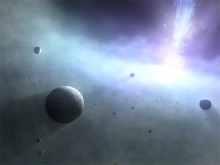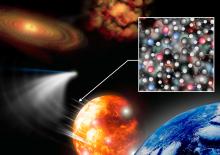Space sciences Astronomy
News
13 Mar 2024
An international research team have made unprecedentedly detailed observations of the earliest merger of galaxies ever witnessed. They suggest stars developed much faster and more efficiently than we thought. They used the James Webb Space Telescope (JWST) to observe the massive object as it was 510 million years after the Big Bang – i.e. around 13 billion years ago.
27 Feb 2024
Jun’ichi Yokoyama once amused his professors by proposing a far-fetched idea of using neutrinos and gravitational waves to observe the Universe. Decades later, he was proven right and contends young scientists should be nurtured to believe in themselves.
01 Feb 2024
Theoretical predictions have been confirmed with the discovery of an outflow of molecular gas from a quasar when the Universe was less than a billion years old.
19 Jan 2024
A recent paper published in the journal Astronomy & Astrophysics presents new images from the 2018 data that reveal a familiar ring the same size as observed in 2017. This bright ring surrounds a deep central depression, “the shadow of the black hole,” as predicted by general relativity. Excitingly, the peak brightness of the ring has shifted by about 30º counter clockwise compared to its position in 2017, which is consistent with our theoretical understanding of the variability of the turbulent material around black holes.
22 Nov 2023
Osaka Metropolitan University researchers and their colleagues have successfully detected an ultra-high-energy cosmic ray with an energy level comparable to the most energetic cosmic ray ever observed. The cosmic ray is set to be named after the Japanese sun goddess, Amaterasu. No promising astronomical object has been identified in the direction from which this cosmic ray originated, implying the potential existence of unknown astronomical phenomena and novel physical origins beyond the Standard Model.
29 Sep 2023
Observations during two flybys by the Mio spacecraft as part of the BepiColombo International Mercury Exploration Project have revealed that chorus waves occur quite locally in the dawn sector of Mercury. Mercury's magnetic field is about 1% of that of Earth, and it was unclear whether chorus waves would be generated like on Earth. The present study reveals that the chorus waves are the driving source of Mercury’s X-ray auroras, whose mechanism was not understood.
08 Mar 2023
One astronomer never thought of leaving Japan, but then he did and became a world best.
28 Feb 2023
Osaka Metropolitan University scientists identified about 140,000 molecular clouds in the Milky Way Galaxy from large-scale data of carbon monoxide molecules, observed in detail by the Nobeyama 45-m radio telescope. Using artificial intelligence, the researchers estimated the distance of each of these molecular clouds to determine their size and mass, successfully mapping the distribution of the molecular clouds in the Galaxy in the most detailed manner to date.
03 Feb 2023
Researchers used the James Webb Space Telescope to identify the precise location of a powerful energy source hidden by cosmic dust in the luminous merging galaxy IIZw096.
25 Oct 2022
Small neighboring galaxy filled with dark matter detected with gamma rays, How a virus induces heart inflammation, Shedding light on the happy hormone, Microfossils may hold key evolution clues. Read all in the October's Editor's Choice plus Upcoming event KNOWLEDGE MARKETPLACE – Bangkok 2022: Exchanging of ideas for a Democratic Myanmar.
13 Oct 2022
Puzzling image from the James Webb Space Telescope explained in two new studies
03 Oct 2022
Supermassive black holes can launch fast-moving plasma, which emit strong radio signals known as radio jets. Despite being discovered over 40 years ago, much remains unknown about how radio jets are produced. Now, a research team, led by Tohoku University astrophysicists, has attempted to clarify how plasma gets loaded into radio jets.
04 Apr 2022
Far from the white sandy beaches and palm trees of Honolulu, Hawaii, astronomers from around the world travel to the top of a volcano that looks like a plateau on Mars. Naoyuki Tamura, a project associate professor at the Kavli Institute for the Physics and Mathematics of the Universe, has been making that same journey to the top of Maunakea to supervise the construction of a new instrument for the Subaru Telescope.
06 Jul 2021
Researchers have used the latest wireless technology to develop a new radio receiver for astronomy. The receiver is capable of capturing radio waves at frequencies over a range several times wider than conventional ones, and can detect radio waves emitted by many types of molecules in space at once. This is expected to enable significant progresses in the study of the evolution of the Universe and the mechanisms of star and planet formation.
27 Sep 2020
Researchers have shaken up a once accepted timeline for cataclysmic events in the early solar system. Geological and geochemical records indicate that the Earth-Moon system experienced a period of frequent and cataclysmic impacts from asteroids and other bodies. It was thought that this period had a relatively sudden onset, but the researchers have found evidence that this bombardment period may have started much earlier, and decreased in intensity over time.
27 Mar 2020
Astronomers obtained the first resolved image of disturbed gaseous clouds in a galaxy 11 billion light-years away by using ALMA.
24 Mar 2020
Astronomers have captured new, detailed maps of three nearby interstellar gas clouds containing regions of ongoing high-mass star formation.
09 Mar 2020
Researchers found that dust encircling a young gas giant can create a “safety zone,” which keeps a large moon from falling into the planet as the system evolves.
05 Mar 2020
An international team of astronomers using ALMA has captured the very moment when an old star first starts to alter its environment.
14 Feb 2020
Planetary scientists using ALMA revealed the secrets of the atmosphere of Titan, the largest moon of Saturn.
17 Jan 2020
Astronomers at the National Astronomical Observatory of Japan have analyzed the paths of two objects heading out of the Solar System and determined that they likely originated from outside of the Solar System.
15 Jan 2020
Astronomers uncovered the true identity of the fireball spotted on April 29, 2017.
09 Jan 2020
Searching for tiny, ancient black holes proposed by Stephen Hawking to see if they might be dark matter.
09 Jan 2020
Astronomers have cataloged signs of 9 heavy metals in the infrared light from supergiant and giant stars.
23 Dec 2019
Astronomers using the Atacama Large Millimeter/submillimeter Array (ALMA) found a young star surrounded by an astonishing mass of gas.
19 Dec 2019
A distant galaxy more massive than our Milky Way has revealed that the 'cores' of massive galaxies in the Universe had formed already 1.5 billion years after the Big Bang.
16 Dec 2019
Researchers have discovered gigantic clouds of gaseous carbon more than a radius of 30,000 light-years around young galaxies using ALMA.
25 Nov 2019
Theoreticians in two different fields defied the common knowledge that planets orbit stars like the Sun. They proposed the possibility of thousands of planets around a supermassive black hole.
19 Nov 2019
Using the Cooled Mid-Infrared Camera and Spectrometer on the Subaru Telescope, astronomers have detected an unidentified infrared emission band from comet 21P/Giacobini-Zinner in addition to the thermal emissions from silicate and carbon grains.
14 Nov 2019
Two peacock-shaped gaseous clouds were revealed in the Large Magellanic Cloud by observations with Atacama Large Millimeter/submillimeter Array.
Events
Sorry, nothing coming up for this discipline
Researchers
Ken’ichi Nomoto is a visiting senior scientist at Kavli IPMU and Professor Emeritus at The University of Tokyo. He is one of the best experts in the world in astronomy and astrophysics, particularly on stellar evolution and supernovae. He was awarded the Order of the Sacred Treasure by the Japanese government in 2020.
Jia Liu is the Director of the Center for Data-Driven Discovery and associate professor at CMB Group at Kavli IPMU. Her research integrates data science techniques in the study of large-scale structures of the universe (dark matter, halos, filaments, voids).
Giants in history
Chinese electron microscopy specialist Li Fanghua (6 January 1932 – 24 January 2020) facilitated the high-resolution imaging of crystal structures by eliminating interference.
Haisako Koyama (1916 – 1997) was a Japanese solar observer whose dedication to recording sunspots – cooler parts of the sun’s surface that appear dark – produced a sunspot record of historic importance.

































